Homemade dumpling skins are better than store bought, and easier to make than you think!
Homemade Dumpling Skins
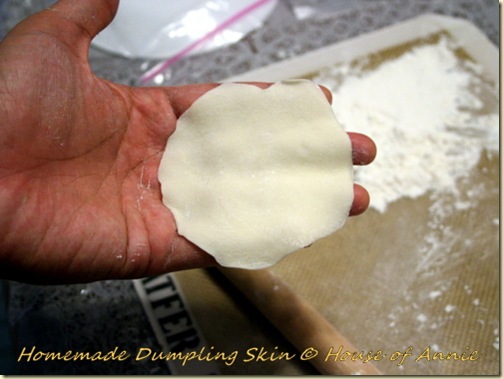 Way back in 1995, I took a tour around China. Of the many memories I cherish, I remember standing in the doorway of a large kitchen, marveling at a group of ladies sitting around the table, rolling out dumpling skins for a jiaozi lunch later. The process (for them) was quick and effortless. How in the world could they turn out such perfect looking skins?!
Way back in 1995, I took a tour around China. Of the many memories I cherish, I remember standing in the doorway of a large kitchen, marveling at a group of ladies sitting around the table, rolling out dumpling skins for a jiaozi lunch later. The process (for them) was quick and effortless. How in the world could they turn out such perfect looking skins?!
If at First You Don’t Succeed
When I returned home to Hawaii, I was invited to a party where some Chinese university students were making dumplings. Again, their skill at dumpling skin rolling was impressive. I tried my hand at making one but it came out woefully lopsided.
Since we were living within heavily Asian communities in Honolulu and San Jose, we had ample access to factory-made, store-bought dumpling skins like the ones we used for our Won Ton Soup recipe. Fresh, store-bought skins are good enough for our use. But I secretly harbored the desire to make my own skins at home.
Get Some Tips First
Last October for our Anniversary, I got Annie the Asian Dumplings cookbook by our friend and fellow food blogger Andrea Nguyen. We were both excited to get the book, and pored over all the recipes trying to figure out which ones we wanted to make. The very first recipe is her Basic Dumpling Dough. That’s a very good place to start!
So when we decided to throw a homestyle Japanese dinner party for our friend Paul and his family, we knew gyozas were going to be on the menu. Earlier in the day of the party, I prepared the dough:
Basic Dumpling Dough
taken from “Asian Dumplings” by Andrea Nguyen
Ingredients:
10 ounces (2 cups) unbleached all-purpose flour
about 3/4 cup just-boiled water
Method:
1. Put flour in a bowl and make a well in the center. Stir the flour while you add the water in a steady stream. Keep mixing until you have a shaggy dough.
Mixing Water into Dumpling Dough
2. Knead the dough to bring it together into one large ball.
3. Transfer the dough to a floured work surface (I used a Silpat silicone baking mat) and knead it for a couple of minutes until it becomes smooth and elastic. Seal the dough in a zip-top plastic bag and let it rest for up to 2 hours.
Kneaded Dumpling Dough
4. After the rest, pull out the dough and cut it into 4 roughly equal sections. Roll each section into a 1-inch thick log, then cut each log into 8 pieces. Shape each piece into a thick coin or disc. Lightly flour the top and bottom of each disc.
5. Andrea recommends using a tortilla press to flatten out each dough disc. We don’t have a tortilla press, so we used two small plates and a cut-up sandwich bag to press them flat.
6. Now here comes the fun part. Holding the flattened disc gently, use a dowel rolling pin to press on just the outer edges of the disc. Roll back and forth once, then rotate the disc. Roll, rotate. Roll, rotate. Add a little flour if necessary to keep it from sticking and tearing.
Rolling out Dumpling Skin
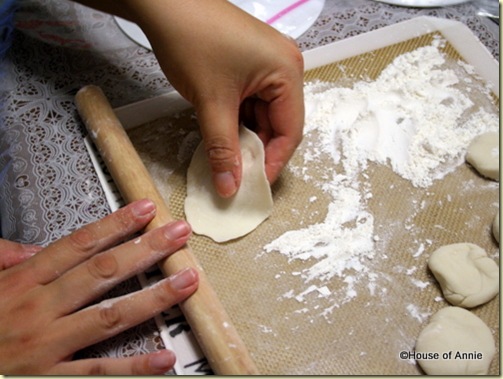
7. You don’t want to make it too thin. It has to be thick enough to hold whatever filling you’re going to put in it. The final dumpling skin should be just over 3 inches in diameter.
Finished Homemade Dumpling Skin
(If you need to see the rolling process in action, Andrea just uploaded a new YouTube video on “How to roll out Asian dumpling wrappers”.)
Try, Try Again
Since Annie was making and wrapping the gyoza, she let me finish rolling out the dumpling skins. And guess what? With enough practice, I got to be good at it! I was more than happy – I was giddy with glee 😀
I had finally made my own dumpling skins, skins I could be proud of!
Thanks, Andrea, for your wonderful cookbook! We will definitely be cooking (and posting) more recipes from it in the years to come.
Aloha, Nate
I am entering this post in the Presto Pasta Nights roundup, hosted this week by Once Upon a Feast.

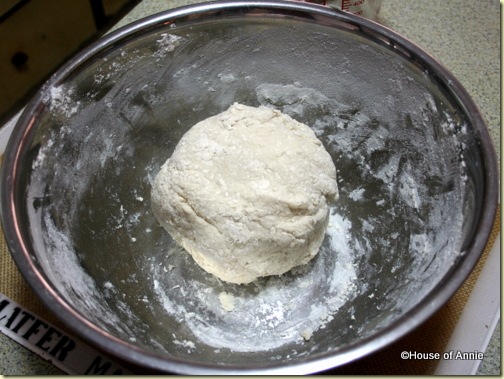

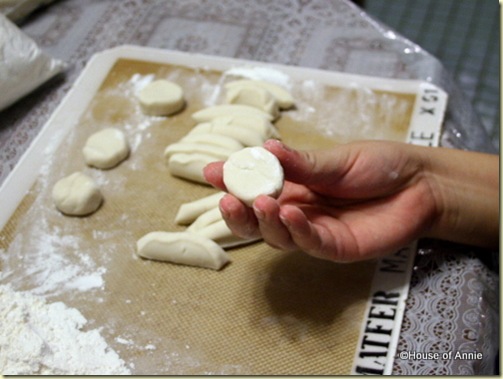
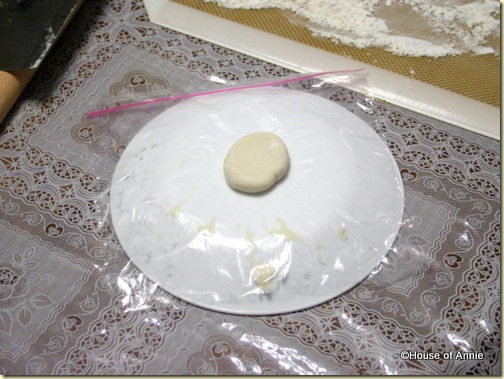
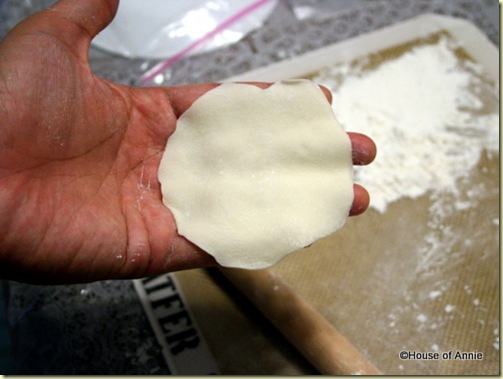
This is just too cool! Just finished making dumplings and think this would be much better and far more delicate in nature. Thanks for sharing.
Now, run over to FoodBuzz and vote for my Solar Cooked Coconut MahiMahi in the Food Joust contest! All of you! 😎
I'm with Peter – you both are amazing.
Thanks for sharing such a great post with Presto Pasta Night.
I can't wait to give it a try.
@all – thanks for your comments!
@Peter – really, you're too kind! Now you got my curious about making phyllo…
@Bob – thank you!
@Sharlene – you're welcome!
@Ruth – can't wait to see the roundup!
I give you guys credit for making your dumpling skins from scratch. I had to do it once for an empanada recipe and after about the 30th one I wanted to kill myself! 😉
Wow, I should pick this up some time soon! Still using store-bought skins.
I have always believed that home made is more okay than any other. So thank you for this, I can now make dumpling skins without going to the grocery.
@Ben – it helps to do it with a group of people…our two kids had fun pressing the dough into rounds.
@tigerfish – yes, please do! I don't think we'll go back to store-bought.
@dining table – you're welcome!
Great job guys – I discovered Andrea's recipe a few months back and it's impossible to go back to bought wrappers. Once you get the hang of it the homemade ones are just sooooo much better and really worth the investment!
Home made definitely better! I have to try this one day! Thx for sharing 🙂
This is another fine post, Annie & Nate. People tend to forget that jiao-zi and potstickers are really pasta dishes, so the quality of the wrapper is all-important. You're doing a service by passing along your expertise.
I would also say, sort of piggy-backing off of the "no-knead" discussion, that becoming comfortable working with one kind of dough makes it that much easier to deal with every other kind. If you make yourself at ease in kneading bread dough, you'll find that that facility transfers to making pasta, dumpling wrappers, Chinese pancakes–anything made of flour and water.
We've hosted a Chinese New Year party the last couple of years where jiao-zi and guo-tie were the centerpiece–we would roll out and stuff a couple hundred dumplings! We're taking this year off, but I'm sure we'll make a batch for ourselves, at least.
Gong xi fa cai. Happy Year of the Tiger to you~ Brett
Great job! Making the dumpling wraps from scratch really pays of as the texture is much better than those commercialised ones.
@Beck – very true!
@noobcook – I'm sure you can tackle this recipe, no problem!
@Brett – looking forward to kneading more and more recipes in the future!
@Janet – I really like the feel of freshly made skins.
Do you think it's ok to use rice flour so they are gluten free?
hey i wanted to know…do you just seal in the filling then boil them?
Mari,
check out our Pan-Fried Gyoza post which has a video on how to pleat and seal a dumpling
https://www.houseofannie.com/pan-fried-gyoza/
Do you know approximately how many skins this recipe will make? Is this about the same amount as a store bought package?
Makes around 30-40 skins, depending how small and thin you make them.
Thank you for this post! I had left over pork and no dumpling skins. I just made the dough and am super excited about cooking them. I will let you know how they come out!
They were amazing!
hello..pls send your recipe of dumplings skin to my email..thanks a lot..god bless.
here’s my email ads>>> mamcy@live.com
ive been looking for a recipe for dumlings..i just love them, my question is i know how to fill them but with what my version of filling is chunks and the dumplings you buy from a store pre-made are not chunked..please help….
ruthie, grind or finely mince your filling. I’ve been researching homemade ravioli, and a tip I found from a blogger whose grandmother and mother taught him how to make them, was to cook the meat and then grind in a meat grinder. You can also use a food processor, just pulse until it’s a fine grind – you don’t want a puree. I haven’t made dumplings yet, but I assume the same principal applies – grind or finely mince. Non-meat ingredients would be a fine chop or minced.
I had to add a bit more hot water than what is in the recipe. It was so easy to make, so thank you. I rolled the dumpling skin out on the kitchen bench with a large rolling pin ( just like a big piece of pastry). Then I used the round cutter to cut out the perfect round shape. Much easier and quicker that way and plus you get the perfect shape just like from the shop 🙂
Thats such an awesome idea i made the recipe once before and had just come back to make sure i remembered it right but I’m gonna try that method instead, easier and i have no help my bf says if he tries to help then i start messing up and second guessing myself so here i go.
Thanks for posting this! I found it through Google and am now enjoying my own homemade pot stickers. Delicious!
Zara,
great, I’m glad you are enjoying this! Don’t forget to share with your friends 😉
Oh, I already have. 🙂
this is far better than what frodo eats on the journey to mordor. thank you i will try it!
Thank you for this post. I’ve been making dumplings my whole life using skins bought at the supermarket. I wanted to try to make fresh skins with no preservatives. They were delicious! This was extremely informative and really easy to follow. Thank you for helping me!
Chrissy,
you’re welcome, and thank you for the great comment!
Can I make the dunpling skins in advance? If so, what’s the best way to keep them and how long can they be kept?
Thank u 🙂
It is spelled “jiaozi”, pronounced “gee-OW-ze (with the ze part rhyming with the “lu” part of “luck”}. Not sure if anyone else corrected you on this, didn’t have time to read it through. But I’m an american living in Shanghai, speak a fair bit of Chinese, and eat local jiaozi 2-3 times a week (street food). And to get technical about it, the dumpling is a jiaozi. The wrapper is called a jiaozipi (“gee-OW-ze-pee”).